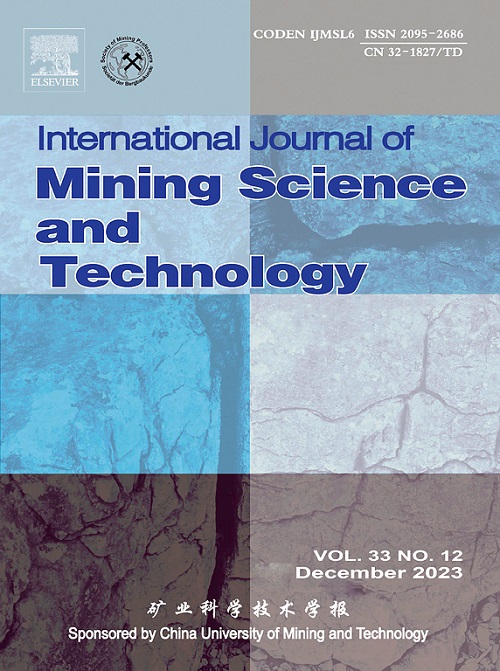铜浮选中磁黄铁矿上部结构的抑制:同步x射线粉末衍射和DFT研究
IF 13.7
1区 工程技术
Q1 MINING & MINERAL PROCESSING
International Journal of Mining Science and Technology
Pub Date : 2025-08-01
DOI:10.1016/j.ijmst.2025.07.002
引用次数: 0
摘要
磁黄铁矿天然赋存于多种上部结构中,包括磁性(4C)型和非磁性(5C、6C)型,每种上部结构具有不同的物理化学性质和浮选行为。准确识别和量化这些上层结构的挑战阻碍了浮选过程中磁黄铁矿抑制的优化。为了解决这一关键问题,采用同步加速器x射线粉末衍射(S-XRPD)和Rietveld精细化技术,量化了某铜金矿给矿和浮选精矿中上部结构的分布。为了阐明影响沉降的机制,采用密度泛函理论(DFT)计算,探索磁黄铁矿上部结构对水吸附的电子结构和表面反应性。氧和羟基离子(OH−)是浮选过程中的优势离子。S-XRPD分析表明,磁黄铁矿的浮选回收率依次为4C<;6C<5C。DFT计算表明,Fe 3d和S 3p轨道带中心相对于费米能级表现出相似的趋势,其中4C最接近。Fe三维带中心表明,4C结构对氧还原反应具有更强的反应表面,促进了亲水性Fe- oh位的形成。s3p波段中心序也表明,黄原药在非磁性的5C和6C表面可以氧化成二氧原,增加了疏水性和可浮性,而4C表面形成疏水性较小的金属-黄原药配合物。对水、羟基离子和分子氧的吸附能和电荷转移分析进一步支持了4C磁黄铁矿的高反应性和亲水性。与羟基离子的强结合表明亲水性Fe-OOH配合物增强了表面钝化作用,与实验观察到的浮选顺序(4C<6C<5C)一致。这些发现提供了实验浮选结果与电子结构计算之间的令人信服的相关性,为优化浮选过程和改善磁黄铁矿抑制提供了重要的见解。这一突破为提高矿业浮选过程的效率开辟了新的机会。本文章由计算机程序翻译,如有差异,请以英文原文为准。
Depression of pyrrhotite superstructures in copper flotation: A synchrotron X-ray powder diffraction and DFT study
Pyrrhotite naturally occurs in various superstructures including magnetic (4C) and non-magnetic (5C, 6C) types, each with distinct physicochemical properties and flotation behaviors. Challenges in accurately identifying and quantifying these superstructures hinder the optimization of pyrrhotite depression in flotation processes. To address this critical issue, synchrotron X-ray powder diffraction (S-XRPD) with Rietveld refinement was employed to quantify the distribution of superstructures in the feed and flotation concentrates of a copper–gold ore. To elucidate the mechanisms influencing depression, density functional theory (DFT) calculations were conducted to explore the electronic structures and surface reactivity of the pyrrhotite superstructures toward the adsorption of water, oxygen and hydroxyl ions (OH−) as dominant species present in the flotation process. S-XRPD analysis revealed that flotation recovery rates of pyrrhotite followed the order of 4C<6C<5C. DFT calculations indicated that the Fe 3d and S 3p orbital band centers exhibited a similar trend relative to the Fermi level with 4C being the closest. The Fe 3d band center suggested that the 4C structure possessed a more reactive surface toward the oxygen reduction reaction, promoting the formation of hydrophilic Fe-OH sites. The S 3p band center order also implied that xanthate on the non-magnetic 5C and 6C surfaces could oxidize to dixanthogen, increasing hydrophobicity and floatability, while 4C formed less hydrophobic metal-xanthate complexes. Adsorption energy and charge transfer analyses of water, hydroxyl ions and molecular oxygen further supported the high reactivity and hydrophilic nature of 4C pyrrhotite. The strong bonding with hydroxyl ions indicated enhanced surface passivation by hydrophilic Fe–OOH complexes, aligning with the experimentally observed flotation order (4C<6C<5C). These findings provide a compelling correlation between experimental flotation results and electronic structure calculations, delivering crucial insights for optimizing flotation processes and improving pyrrhotite depression. This breakthrough opens up new opportunities to enhance the efficiency of flotation processes in the mining industry.
求助全文
通过发布文献求助,成功后即可免费获取论文全文。
去求助
来源期刊

International Journal of Mining Science and Technology
Earth and Planetary Sciences-Geotechnical Engineering and Engineering Geology
CiteScore
19.10
自引率
11.90%
发文量
2541
审稿时长
44 days
期刊介绍:
The International Journal of Mining Science and Technology, founded in 1990 as the Journal of China University of Mining and Technology, is a monthly English-language journal. It publishes original research papers and high-quality reviews that explore the latest advancements in theories, methodologies, and applications within the realm of mining sciences and technologies. The journal serves as an international exchange forum for readers and authors worldwide involved in mining sciences and technologies. All papers undergo a peer-review process and meticulous editing by specialists and authorities, with the entire submission-to-publication process conducted electronically.
 求助内容:
求助内容: 应助结果提醒方式:
应助结果提醒方式:


